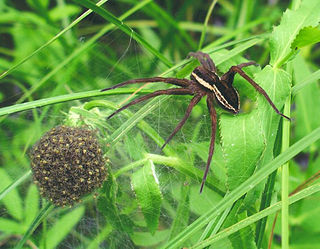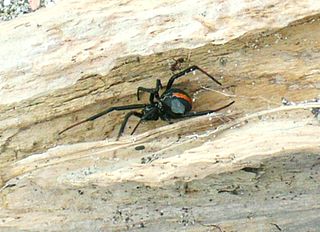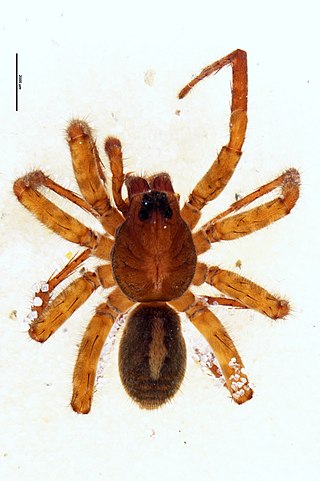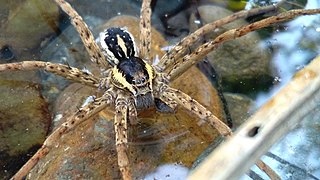
Dolomedes is a genus of large spiders of the family Dolomedidae. They are also known as fishing spiders, raft spiders, dock spiders or wharf spiders. Almost all Dolomedes species are semiaquatic, with the exception of the tree-dwelling D. albineus of the southeastern United States. Many species have a striking pale stripe down each side of the body.

Dolomedes minor is a spider in the family Dolomedidae that is endemic to New Zealand, where it is known as the nursery web spider.

New Zealand has 1157 described spider species, with an estimated total fauna of 2000 species. Over 97 per cent are endemic, and the rest have been introduced through human activities or were natural wind-borne introductions.

Anoteropsis aerescens is a species of wolf spiders that is endemic to New Zealand.
Augacephalus breyeri is a species of harpactirine theraphosid spider, found in South Africa, Mozambique and Eswatini.

Dolomedes schauinslandi or the Rangatira spider is a large spider of the family Dolomedidae. It is only found on South East Island (Rangatira), Houruakopara and Mangere Islands in the Chatham Islands, New Zealand. It is one of New Zealand's largest and rarest spiders.

Evarcha bakorensis is a species of jumping spider in the genus Evarcha that lives in Guinea, Ivory Coast and Nigeria. It thrives in savanna grasslands. The species was first described in 2002 by Christine Rollard and Wanda Wesołowska. The spider is small, with a cephalothorax measuring between 1.6 and 1.8 mm long and an abdomen that is between 1.3 and 1.9 mm long. The female is larger than the male. The cephalothorax has a light brown topside, or carapace, yellow underside, or sternum, and darker sides. The abdomen is greyish-brown or brown and has a lighter pattern on it. The spider has generally brown legs. It has distinctive copulatory organs. The female has a large membrane in the centre of its epigyne while the male has a straight and blunt tibial apophysis, or projection on its palpal tibia.

Evarcha certa is a species of jumping spider in the genus Evarcha that lives in Guinea and Ethiopia. It thrives in grasslands, particularly near bodies of water like the Baro River and in areas of high altitude such as the Guinea Highlands. The species was first described in 2002 by Christine Rollard and Wanda Wesołowska. The spider is small, with a cephalothorax measuring between 2.6 and 2.9 mm long and an abdomen that is between 2.7 and 3.4 mm long. The cephalothorax has a reddish-brown topside, or carapace, with a darker eye field, and an orange underside, or sternum. The abdomen has a pattern consisting of irregular brown patches, although this differs between individual spiders. The spider has orange or yellow legs. It has distinctive copulatory organs. The female has relatively simple spermathecae that are heavily sclerotized and short insemination ducts. The male has not been described.
Evarcha maculata is a species of jumping spider in the genus Evarcha that lives in Guinea, Ivory Coast and Ethiopia. It has been found in savanna in the Guinea Highlands and near bodies of water like the Awash River. The species was first described in 2002 by Christine Rollard and Wanda Wesołowska. The spider is small, with a cephalothorax measuring between 1.7 and 2.3 mm long and an abdomen that is between 1.6 and 3.6 mm long. The female is generally larger than the male, although there are exceptions, particularly amongst those found in Guinea. The cephalothorax has a yellowish topside, or carapace, with a darker eye field, and a yellow or yellowish-orange, or sternum. The abdomen has a distinctive pattern that is basically shaped like a capital "H", referred to in the species name, which can be translated "spotted". The spider has orange or yellow legs. It has distinctive copulatory organs. The female has distinctively shaped insemination ducts. The male has a very short curved embolus.
Thiratoscirtus procerus is a species of jumping spider in the genus Thiratoscirtus that lives in Nigeria. The species was first described in 2012 by Wanda Wesołowska and Glavis Edwards. It is a medium-sized spider with a slender body, which is recalled in the name, that is more reminiscent of a spider in the genus Brancus. It has a cephalothorax that is between 3.2 and 3.3 mm long and a larger abdomen that is between 4.4 and 5.6 mm in length, both oval in shape. The top of the cephalothorax, or carapace, is yellowish-orange and the bottom, or sternum, is yellow. The top of the abdomen is yellowish was an orange pattern and the bottom is yellowish-white. The spider's legs are also yellow. They are long and thin and have very long brown spines. The female has copulatory organs that are typical for the genus. The male has not been described.

Muritaia suba is a species of Amaurobiidae, endemic to New Zealand.

Anoteropsis hilaris, commonly referred as the garden wolf spider or the grey wolf spider, is a species of wolf spider that is endemic to New Zealand.

Anoteropsis cantuaria is a species of wolf spider that is endemic to the Canterbury Plains of New Zealand.

Dolomedes dondalei is a species of large fishing spider endemic to the main islands of New Zealand. It is a nocturnal hunter, feeling the water surface for vibrations, and catches insects and even small fishes – the only New Zealand Dolomedes species able to do so.
Detalik anthonyi is the type species for the genus Detalik. It is a species of jumping spider that is endemic to Nigeria and was first described in 2021 by Wanda Wesołowska. A small spider like all those in the genus, it has a cephalothorax measuring between 1.7 and 2.2 mm long and an abdomen between 1.5 and 2.7 mm long. The cephalothorax has a brown top or carapace that has wide white stripes on its back and a yellow underside or sternum. The abdomen differs between the sexes. The female abdomen is brownish-grey with a lighter streak running down it while the male has a mosaic-like pattern of brown dots at the very rear. The spider has distinctive copulatory organs. The male has an irregular-shaped palpal bulb with characteristic spikes, or apophyses. One, that is attached to the bulb itself, is large and sickle-shaped; two others are much shorter. The female has copulatory openings to the sides of the epigyne that lead to particularly long insemination ducts.
Detalik idanrensis is a species of jumping spider in the genus Detalik. It is endemic to Nigeria and was first described in 2021 by Wanda Wesołowska. A small spider like all those in the genus, it has a cephalothorax measuring typically 1.9 mm (0.07 in) long and an abdomen typically 1.7 mm (0.07 in) long. The cephalothorax has a brown top, or carapace, with a thin lighter line running down it and a light brown underside, or sternum. The abdomen is yellow underneath butalso brown on top with a lighter streak running down much of the surface. The spider has distinctive copulatory organs. The female has unusually large large spermathecae, or receptacles. The male has not been described.
Migas sandageri is a species of mygalomorph spider endemic to New Zealand.
Haplinis minutissima is a species of sheet weaver spider endemic to New Zealand.
Haplinis rupicola is a species of sheet weaver spider endemic to New Zealand.

Metamynoglenes helicoides is a species of sheet weaver spider endemic to New Zealand.













